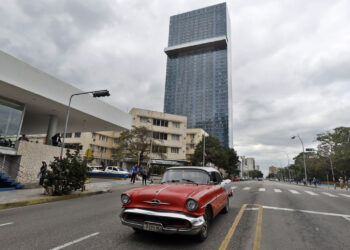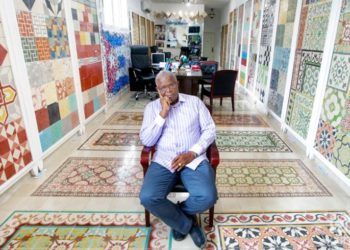All forms of art, trends and styles, combined in full harmony. That is Viviart, a project that strives to promote our culture, but also to enrich it through the combination of all lines of creation. Nine professionals and a large number of collaborators building a space for all the good art that is made in our Island.
OnCuba had the possibility to contact some of its members: Giselda Hernández, in charge of plastic arts; Vivian Batista, in the music section; Julie Rabelo, in Projects, and Dadne Carbonell, who, in her own words, “more or less leads the conga”. The conversation with the Viviart team is an entertaining dialogue that shows its nature of ambitious project which, despite its short age, has found to way to achieve its purposes.
How did Vibraciones Vitales del Arte (Vital Vibrations of Art – VIVIART) start and why?
Dadne: The idea came to me three years ago, during the Days of Cuban Culture held in Pabellón Cuba. Different forms of art were present in the same place: an exhibition hall, troubadours, large-format groups, but in the end it did not seem to me that the public realized the general purpose of connecting different trends.
I thought Viviart could be a space where several forms of art would come together and achieve a purpose. Since then the project has derived into something more solid. We devote ourselves to promote the artists in our catalogue and to show how Cuban culture works, the one that does not receive full support from the institutions.
Vivian: Viviart is a project with interest in all kinds of Cuban art, provided it is genuine art and with quality. We will not be pigeonholed in only one trend; in music there are producers dedicated to hip hop, others to the trova, etc.
Julie: The possibilities extend from the dialogue and the enriching of forms to the enriching of cultures. For example, a communitarian project involves neighbors, artists and several art forms, and something new emerges from it.
Is it an independent project?
Dadne: We are a cooperative, friends who have come together to do things. Whenever you mention the word “independent” you are asked where the money comes from. For the financing of the project we receive help from schools in other countries, interested in Cuban culture, and associations with objectives that are similar to ours.
How does Viviart intend to promote our culture?
Vivian: The most important is that Viviart shows the persons who come to learn about our genuine culture a culture that is not sweetened. These tours show very interesting things that are not to be found in other exchanges. For instance, we visit the artists’ homes, where the visitors may ask how they work, how they create.
Giselda: We show what is happening in Cuba everyday. We do not prepare a place for the visitors to see, the purpose is to show them what is taking place, the latest concert or festival.
Julie: There is interest in these exchanges, it is the links that fail, many people want to come to Cuba to make art. We promote a meeting with real Cubans, personal and personalized meetings.
Dadne: The exchanges are not tours. What we do is show art. We go, for example, to Regla and simply say: this is Regla, do you want to see a toque de santo (religious ceremony of African origin)? At present there are art schools that contact us because they are interested in Cuban culture. We organize a gathering, an exchange like the one that recently took place in Trinidad with Danish artists, where musicians from both countries shared the stage. For 2013 we plan to celebrate a meeting with U.S. artists interested in exchanging with Cuba.
The work carried out by Viviart for the promotion of Cuban art entails combining different art forms, working directly with the artists. How do you create the catalogue?
Dadne: We avoid hurting sensibilities, but not everyone can be accepted. The team decides who participates in the project according to their aesthetics and what they stand for. We look for young artists who receive little promotion, who practice quality art and whose form of art is liable to be accepted by the youth and society in general. It does not matter whether they are empirical artists or whether they have studied or belong to an institution.
We do not promote artists who are already established, like the ones dedicated to popular music or regueton; they do not need us. However, there is much art in the streets with no space, and it is important to create a place for them, too.
Giselda: As regards plastic arts, we are not interested in working with artists who participate in fairs, which are strictly commercial, nor with famous painters. We visit the exhibitions and valuate the work, because there are many unknown artists. There are also those who hear about our project and contact us.
Julie: That does not mean that we do not work with artists with a solid work. In fact, we nourish from them, we favor exchanges between two different generations that enrich one another: the fresh element of the new generations meets other schools.
In its task of bringing together styles and art forms, Viviart has reached all of Cuba. What are your experiences with the communitarian meetings?
Julie: The idea of coming in contact with the community began when the artists who lacked space to express themselves thought precisely of the community. “I have nowhere to go, but why look for a place? My house can be a center of creation where I give a different perspective to the people”. If there were artists doing this and other who wanted to, we could all help. The work is also educational. We go to the places to show what is art, we teach why a graffiti can be art and not vandalism.
Dadne: I will tell you a story. In Santiago de Cuba we worked with the project Sonido Urbano, which takes art to the places with the greatest social problems. Being there, they were organizing the exhibition of a Brazilian documentary in Portuondo, one of these neighborhoods. When we arrived the people were in the street watching the documentary on a screen. Everybody interacted with us, they had their picture taken with Raudel, with Aldo. It was a very pretty exchange.
Viviart also organizes concerts. How much work does production involve?
Dadne: Well, we are not producers, but if you want to promote art you have to produce, it is a necessary tool. To give a concert in Cuba, first you have to receive support from the institutions; so far we have had no problem in this regard. All the places we have contacted regarding a project have agreed. They have not even refused artists who in some way strongly criticize society. The sector of Cuban culture we have contacted has opened its doors for us. Each production is unique; perhaps it is not a luxury concert, but the people may go and enjoy it.
But in addition to organizing concerts you also produce audiovisuals…
Dadne: Yes, we are doing a documentation work. The audiovisual is the memory of what we do. We have an archive where we keep the recordings of the concerts; we keep them to show them when timely. We also hang the videos in Youtube or in our website, and give them to the artist as a means of promoting his or her work. If any institution or recording house is interested in the product we make and wants to come to an agreement with the artist and with us for the commercialization, our doors are open.
Viviart has achieved a great deal in two years. What are your upcoming projects?
Giselda: At the same time that we cover all the activities of the plastic artists included in the catalogue, we organize several exhibitions. Next October we will have one in Hotel Palco, precisely where Viviart had its premiere. In November we will present an exhibition by Tomys Ortiz at the Center for the Development of the Visual Arts in Havana, including a performance, and we are creating conditions to exhibit in Brazil next year.
Dadne: Last Saturday we had a concert by female interpreters: Sigrid, the Jade duet, M Alfonso, among others. Each one of them has her peculiar aesthetics and style, we would like to take this project to the provinces and have local artists there join us. We are preparing a concert of Escuadron Patriota on August 29, hopefully the date will not change; it is a very complex concert with a full band of musicians. In addition we are coordinating a special concert abroad, where we will combine plastic arts with the music of rap singers Alexei, “el tipo este” (this guy) and Raudel.
Every time we launch a project we do not know the scope it may have. What Viviart always wants is to give the public the possibility to interact with different forms of art in the same space. Our dream is that a son dancer may attend a rock concert.










